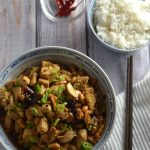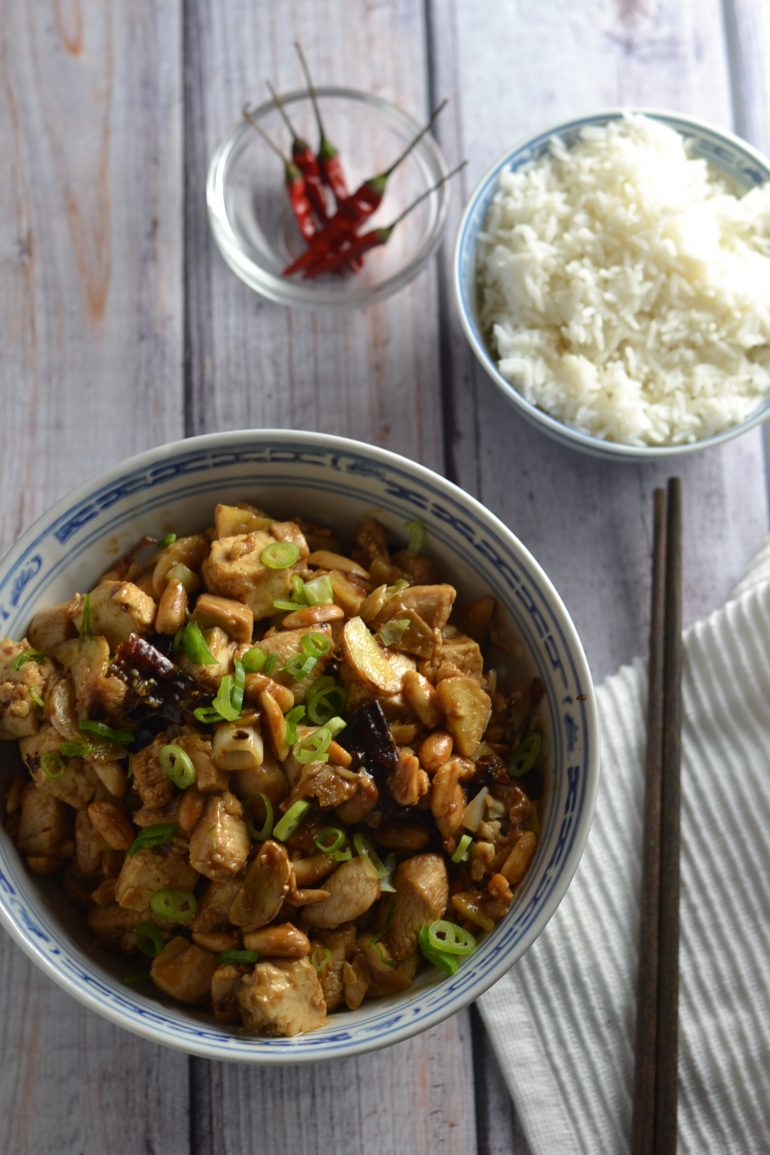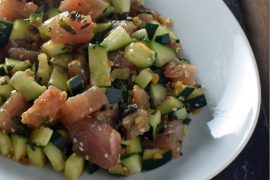As our readers know, we at New York Food Journal are especially fond of Sichuan cuisine, with its big flavors and fiery heat delivered by the potent trinity of garlic, ginger, and chilies. We have previously reviewed some good Sichuan restaurants in New York City and Connecticut, which offer classics like mouth-burning ma po tofu, juicy tea-smoked duck, and aromatic cumin lamb (not to mention our beloved Sliced Fish with Spicy Sauce Soup). A few choice ingredients open up a world of Sichuan cooking at home.
Kung Pao chicken is one of the most famous Sichuan staples, with a tangy sweet and sour flavor backed by the breath of chilies. Soy sauce is used only as seasoning, similar to salt in Western cooking, and it takes a back seat to the savory garlic and ginger, the bitter crunch of peanuts, the warmth of Shaoxing wine, and the sweet-tartness of black Chinkiang vinegar. The flavors are rounded out by the unique tongue-tingling sensation of Sichuan pepper, which characterizes the region’s cuisine. The chicken should be just cooked-through and tender. It bears only a passing resemblance to the lackluster dish offered on takeout menus.
For dinner on Sunday, we added some firm tofu for a flexetarian version of the classic. The tofu absorbed the sauce more thoroughly than the chicken, giving it an even more potent flavor.
This recipe is adapted from Land of Plenty, the classic Sichuan cookbook by food writer Fuchsia Dunlop, and it employs a few ingredients not always found in the American pantry. If you don’t have Sichuan peppercorns, get some! Or leave them out. For other ingredients, see the bottom of this post for suggested substitutions.

Kung Pao Chicken (and Bean Curd)
Ingredients
- ⅔ pound boneless skinless chicken breasts
- 3 cloves garlic
- Fresh ginger equal amount to the garlic
- 5 scallions
- 2 tablespoons peanut oil
- 10 or more dried red chilies
- 1 teaspoon whole Sichuan peppercorns
- ½ cup roasted unsalted peanuts
For the Marinade
- ½ teaspoon salt
- 2 teaspoons light soy sauce
- 1 teaspoon Shaoxing rice wine or medium-dry sherry
- 2 teaspoons cornstarch
For the Sauce
- 3 teaspoons sugar
- 1 teaspoon cornstarch
- 1 teaspoon dark soy sauce
- 1 teaspoon light soy sauce
- 1 tablespoon Chinkiang vinegar
- 1 teaspoon sesame oil
Instructions
-
Cut the chicken into ½ inch strips and cut the strips into ½ inch cubes. Place them in a bowl with the marinade ingredients. Mix and set aside. In a separate bowl, combine the sauce ingredients.
-
Do your prep: Peel and thinly slice (do not chop or mince) the garlic and ginger. Slice the white parts of the scallions into chunks about as long as they are wide, so that they have a cube shape to match the chicken. Thinly slice some of the green parts and set aside to garnish the plate later. Snip the chilies in half with a pair of scissors and remove the seeds, using gloves or an appropriate kitchen tool. Measure out the peanuts and Sichuan pepper. Set everything next to the stove and prepare a serving dish - things will go quickly once the flame goes on.
-
Heat a well-seasoned wok over high heat and add the peanut oil. When it is hot but not yet smoking, add the chilies and Sichuan peppercorns and fry for 30-60 seconds until they are fragrant.
-
Add the chicken, followed by the garlic, ginger, and scallions. Stir-fry until the chicken is opaque and just cooked through. This should take about five minutes, but test by cutting through one of the thicker pieces.
-
Give the sauce ingredients a good stir and add them to the wok, tossing the sauce with the chicken. When the sauce has thickened, add the peanuts. Give everything a good stir and remove to a serving dish.
-
Top the dish with the thinly-sliced scallions and serve with some steamed rice, a cold beer, and a box of tissues.
-
Variation: For a flexetarian version, reduce the chicken to ½ pound and add 7 ounces (half a package) of firm tofu. Drain it and dry it well with paper towels, then cut it into ½-inch cubes to match the chicken. Do not marinate the tofu. Instead, add it to the pan about 3 minutes after the chicken goes in, before the sauce.
Here are some suggested substitutions for ingredients that are not always in the American pantry:
- If you do not have peanut oil, substitute sesame oil or a neutral oil like vegetable or canola.
- If you do not have Shaoxing rice wine, substitute a medium-dry sherry.
- If you do not have dark soy sauce, substitute an additional 1/2 teaspoon regular light soy sauce.
- If you do not have Chinkiang vinegar (or another Chinese black vinegar), use rice vinegar and add an additional teaspoon of sugar. This is a great ingredient that makes a fantastic dipping sauce for dumplings, so consider buying some!





Looks spicy!
I have been visiting your recipe blog from past 3 months. The way of recipe tips looks to be easy for all readers. I would personally recommend our blog visitors to subscribe to obtain useful posts like this periodically. Particularly post on “Sichuan Kung Pao Chicken with Peanuts” is awesome. Get in touch with us via our websites http://www.aabsweets.in
Looks delicious, you make me hungry :))